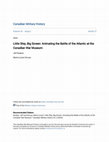Books by Jeff Noakes
Special Contract: A Story of Defence Communications in Canada, 2019
Special Contract tells the story of Bell Canada’s involvement in the construction of the Mid-Cana... more Special Contract tells the story of Bell Canada’s involvement in the construction of the Mid-Canada Line (also known as the McGill Fence), a series of radar stations running along the 55th parallel to provide early warning of a Soviet bomber attack on North America. Written by Alex Lester, a self-made engineer who headed Bell’s Special Contract Division that oversaw the building of the line during the mid-1950s, it details the project from the tropospheric scatter system that linked the sites to the completion of the microwave towers and stations dotting the mid-Canadian landscape. This important account provides unique insights into the political, logistical, and construction challenges involved in building a radar and communication system in remote Northern locations.
Forged in fire : Canada and the Second World War
The Second World War transformed Canada and its place in the world.
The outbreak of war in Sep... more The Second World War transformed Canada and its place in the world.
The outbreak of war in September 1939, following a decade of economic crisis and the rise of aggressive dictatorships, drew Canada into a second global conflict. Canadians ultimately served in virtually every theatre of operations, while the home front mobilized to support the war effort.
This souvenir catalogue highlights the Museum’s Second World War Gallery. From the powerful to the intimate, artifacts that have borne witness to the conflict -- including artwork, weapons, uniforms, archival documents and photographs -- help show how the war affected Canada and Canadians.
The LeBreton Gallery: The Military Technology Collection of the Canadian War Museum
Experience the LeBreton Gallery, the Canadian War Museum’s superb collection of military artifact... more Experience the LeBreton Gallery, the Canadian War Museum’s superb collection of military artifacts. Get an up-close view of imposing tanks, artillery and other tools of war, and learn about the military technology used by and against Canadians in times of peace and conflict.
This souvenir catalogue presents a wide variety of vehicles and equipment used in warfare over the past 300 years, such as a Voodoo fighter jet, nineteenth-century artillery pieces, tanks, and other vehicles drawn from one of the most extensive collections of its kind in the world. Each tells something about the human ingenuity and intent in their creation and use, and the human experience of facing them.
Book Chapters by Jeff Noakes

Canada, Military Scottishness and the First World War
Users without a subscription are not able to see the full content. A Global Force: War, Identities and Scotland's Diaspora , 2016
This chapter discusses how the outbreak of the First World War led to the widespread use of the i... more This chapter discusses how the outbreak of the First World War led to the widespread use of the imagery of ‘military Scottishness’ in Canada, not only as part of recruiting efforts, but also for other wartime purposes, including propaganda and fund-raising. In some cases, materials made use of Scottish cultural references, even when explicitly “Scottish” images were not present. In a country with numerous identified and self-identifying cultural identities, it is worth noting that many of the materials that made use of “Scottish” imagery were not explicitly targeting Scottish Canadians. This was not always the case for recruiting efforts using imagery associated with other identifiable groups, and suggests that for some at least a Scottish military identity could embrace non-Scots. Much of the chapter’s focus is on the uses and expressions of military Scottishness in First World War Canada, but it also places this experience within a wider context, including the Second World War and into the present day. Overall, this chapter addresses a number of questions about military identity and its relationship to other competing national and cultural identities within Canada.
Papers by Jeff Noakes
The Northern Mariner, 2024
Since 1960, the Canadian War Museum's collection has included a Soviet torpedo whose history long... more Since 1960, the Canadian War Museum's collection has included a Soviet torpedo whose history long remained obscure. Archival research has uncovered its 1951 transportation to Canada as part of a cargo of Soviet-made torpedoes and naval mines captured in North Korea, destined for analysis and training purposes. It has also revealed the intricacies and the implications of the technical analysis of the mines. This article examines the history of these weapons, and suggests some of the wider implications of their acquisition and analysis for the early Cold War Royal Canadian Navy, including potential areas for further research.
Jointly-Authored Papers by Jeff Noakes

Canadian Military History, 2024
The Canadian War Museum developed a large-screen immersive computer-animated video experience for... more The Canadian War Museum developed a large-screen immersive computer-animated video experience for visitors to the Second World War gallery. It is a dramatisation of a Canadian corvette’s nighttime encounter with a German U-boat in the North Atlantic, told from the perspective of the corvette’s crew while escorting a convoy. This article examines and discusses the process of developing the upgrade, including decisions about subject matter and approach, and design and accessibility. The role of archival and historical research in defining these objectives is detailed, together with a behind-the-scenes look at the development and installation of the final product.
Le Musée canadien de la guerre a conçu une expérience vidéo immersive animée par ordinateur et présentée sur un grand écran pour les personnes qui visitent la galerie de la Seconde Guerre mondiale. Il s’agit d’une dramatisation d’une rencontre nocturne entre une corvette canadienne et un sous-marin allemand dans l’Atlantique Nord, racontée du point de vue de l’équipage de la corvette, qui escorte un convoi. Le présent article examine le processus de réalisation de la mise à jour de la galerie, y compris les décisions relatives au sujet et à l’approche, à la conception et à l’accessibilité. Le rôle de la recherche archivistique et historique dans la définition de ces objectifs est décrit en détail. L’article nous plonge également dans les coulisses de la réalisation et de l’installation du produit final.
Canadian Military History, 2012
W hat did Canadian enlisted artists do if they did not become official war artists during the Sec... more W hat did Canadian enlisted artists do if they did not become official war artists during the Second World War? The military career of Guelph, Ontario, artist Evan Macdonald (1905-1972) is a case in point. A well-respected Ontario painter and illustrator, Macdonald trained in Toronto at what is now the Ontario College of Art (1923) and in London, England, at the Chelsea Polytechnic, the Putney School of Art, and the Royal Academy Schools (1926-1931). After his return to Canada in 1931, Macdonald worked for eight years as a commercial artist and illustrator in Toronto before returning, upon the death of his father, to Guelph to run the family department store, D.E. Macdonald Brothers. 1

The origins of Canada's first Eastern Arctic Patrol, 1919–1922
Polar Record, 2009
ABSTRACT: It is widely believed among historians that in 1920, the Danish explorer Knud Rasmussen... more ABSTRACT: It is widely believed among historians that in 1920, the Danish explorer Knud Rasmussen and the Danish government challenged Canada's sovereignty over Ellesmere Island. This paper draws on a wide range of Canadian and British government files and private papers to contest this view. It demonstrates that Prime Minister Arthur Meighen and others in Ottawa were initially convinced by Vilhjalmur Stefansson that Denmark harboured territorial ambitions in the north, but most realised in the spring of 1921 that they had been mistaken. However, one civil servant, J. B. Harkin, stubbornly maintained his belief in the Danish threat. After Mackenzie King's Liberals came to power, Harkin was able to obtain a hearing for his views. It was largely due to Harkin's persistence that the first Eastern Arctic Patrol went north in 1922.

Explorer without a country: the question of Vilhjalmur Stefansson's citizenship
Polar Record, 2009
Confusion has long existed on the subject of Vilhjalmur Stefansson's citizenship. A Canadian (tha... more Confusion has long existed on the subject of Vilhjalmur Stefansson's citizenship. A Canadian (that is, a British subject) by birth, Stefansson was brought up and educated in the United States. When his father became an American citizen in 1887, according to the laws of the time Stefansson too became an American. Dual citizenship was not then permitted by either the British or the American laws. Therefore, Stefansson was no longer a British subject. After he took command of the government sponsored Canadian Arctic Expedition in 1913, Stefansson was careful to give the impression that his status had never changed. Although Stefansson swore an oath of allegiance to King George V in May 1913, he did not take the other steps that would have been required to restore him to being Canadian. But, by an American act passed in 1907, this oath meant the loss of Stefansson's American citizenship. In the 1930s American officials informed Stefansson that he must apply for naturalis...
Conference Presentations by Jeff Noakes
Big Stuff 2013, 2013
The Canadian War Museum (CWM) preserves and displays a sizeable collection of large military tech... more The Canadian War Museum (CWM) preserves and displays a sizeable collection of large military technology artifacts, including weapons and vehicles, in its LeBreton Gallery. This collection is publicly displayed so that visitors can better understand the military technology that Canadians have used, faced, and experienced in times of peace and conflict.
Sic Itur Ad Astra: Canadian Aerospace Power Studies, volume 2: Volume 2 Big Sky, Little Air Force, 2009
Paper given at the 6th Air Force Historical Conference, Cornwall, Ontario, 21-23 June 2000.
Canadian Military History Since the 17th Century: Proceedings of the Canadian Military History Conference, Ottawa, 5-9 May 2000, 2000










Uploads
Books by Jeff Noakes
The outbreak of war in September 1939, following a decade of economic crisis and the rise of aggressive dictatorships, drew Canada into a second global conflict. Canadians ultimately served in virtually every theatre of operations, while the home front mobilized to support the war effort.
This souvenir catalogue highlights the Museum’s Second World War Gallery. From the powerful to the intimate, artifacts that have borne witness to the conflict -- including artwork, weapons, uniforms, archival documents and photographs -- help show how the war affected Canada and Canadians.
This souvenir catalogue presents a wide variety of vehicles and equipment used in warfare over the past 300 years, such as a Voodoo fighter jet, nineteenth-century artillery pieces, tanks, and other vehicles drawn from one of the most extensive collections of its kind in the world. Each tells something about the human ingenuity and intent in their creation and use, and the human experience of facing them.
Book Chapters by Jeff Noakes
Papers by Jeff Noakes
Jointly-Authored Papers by Jeff Noakes
Le Musée canadien de la guerre a conçu une expérience vidéo immersive animée par ordinateur et présentée sur un grand écran pour les personnes qui visitent la galerie de la Seconde Guerre mondiale. Il s’agit d’une dramatisation d’une rencontre nocturne entre une corvette canadienne et un sous-marin allemand dans l’Atlantique Nord, racontée du point de vue de l’équipage de la corvette, qui escorte un convoi. Le présent article examine le processus de réalisation de la mise à jour de la galerie, y compris les décisions relatives au sujet et à l’approche, à la conception et à l’accessibilité. Le rôle de la recherche archivistique et historique dans la définition de ces objectifs est décrit en détail. L’article nous plonge également dans les coulisses de la réalisation et de l’installation du produit final.
Conference Presentations by Jeff Noakes
The outbreak of war in September 1939, following a decade of economic crisis and the rise of aggressive dictatorships, drew Canada into a second global conflict. Canadians ultimately served in virtually every theatre of operations, while the home front mobilized to support the war effort.
This souvenir catalogue highlights the Museum’s Second World War Gallery. From the powerful to the intimate, artifacts that have borne witness to the conflict -- including artwork, weapons, uniforms, archival documents and photographs -- help show how the war affected Canada and Canadians.
This souvenir catalogue presents a wide variety of vehicles and equipment used in warfare over the past 300 years, such as a Voodoo fighter jet, nineteenth-century artillery pieces, tanks, and other vehicles drawn from one of the most extensive collections of its kind in the world. Each tells something about the human ingenuity and intent in their creation and use, and the human experience of facing them.
Le Musée canadien de la guerre a conçu une expérience vidéo immersive animée par ordinateur et présentée sur un grand écran pour les personnes qui visitent la galerie de la Seconde Guerre mondiale. Il s’agit d’une dramatisation d’une rencontre nocturne entre une corvette canadienne et un sous-marin allemand dans l’Atlantique Nord, racontée du point de vue de l’équipage de la corvette, qui escorte un convoi. Le présent article examine le processus de réalisation de la mise à jour de la galerie, y compris les décisions relatives au sujet et à l’approche, à la conception et à l’accessibilité. Le rôle de la recherche archivistique et historique dans la définition de ces objectifs est décrit en détail. L’article nous plonge également dans les coulisses de la réalisation et de l’installation du produit final.